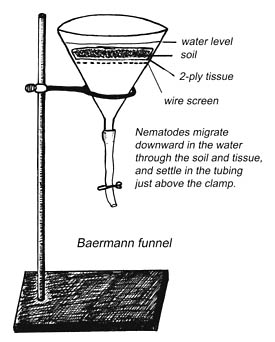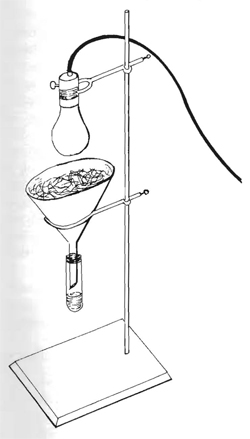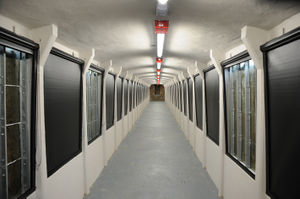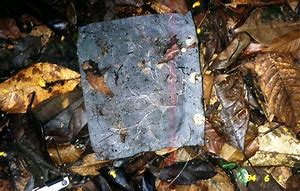Soil Sampling Methods: Difference between revisions
| Line 25: | Line 25: | ||
In a leaf litter pack you fill a mesh bag, usually a small 1/4 inch opening, with leaves and lettuce. The size in the mesh is varying depending on the size of organisms you are looking to catch. Large enough so they can crawl into the bag, and small enough so they do not fall out. When picking where you want to place the leaf pack you want to find a low spot on the ground, as this is where there is the most organisms living. You dig a small hole in the ground, place the bag in the hole and cover it up with the soil and surrounding leaves. place a flag sticking out of the ground next to the bag so you can find it later. Let the leaf pack sit for a couple days to allow organisms to get into the bag before you remove it. Next, you dump the leaves out of the bag onto a plate and start looking for organisms like slugs worms and smaller organisms. You can put them on a petri dish and observe them closer under the microscope. | In a leaf litter pack you fill a mesh bag, usually a small 1/4 inch opening, with leaves and lettuce. The size in the mesh is varying depending on the size of organisms you are looking to catch. Large enough so they can crawl into the bag, and small enough so they do not fall out. When picking where you want to place the leaf pack you want to find a low spot on the ground, as this is where there is the most organisms living. You dig a small hole in the ground, place the bag in the hole and cover it up with the soil and surrounding leaves. place a flag sticking out of the ground next to the bag so you can find it later. Let the leaf pack sit for a couple days to allow organisms to get into the bag before you remove it. Next, you dump the leaves out of the bag onto a plate and start looking for organisms like slugs worms and smaller organisms. You can put them on a petri dish and observe them closer under the microscope. | ||
[[File:Leaf litter pack.jpg|left thumb| Leaf litter | [[File:Leaf litter pack.jpg|left thumb|Leaf litter pack ready to be burried]] | ||
---- | ---- | ||
Revision as of 07:46, 9 May 2018
Soil Sampling Methods

Soil Sampling gives us the best idea of what is in the soil. We can measure things like, the organisms living in the soil, the root structures, leaf litter break down and decomposition. There are different methods for different types of organisms you are trying to extract and vabiables you are trying to observe.
Baermann Funnel
In this method we take a funnel with a small mesh lining on the inside. There is a tube attached to the bottom of the funnel, which is clamped shut at the bottom. When the soil is placed in the funnel you fill up the funnel to the rim with water. This water pushes the small organisms through the filter into the bottom of the tube. Organisms like nematodes will also swim down through the soil and water, through the mesh and into the bottom of the tube. After it sets for 24 to 48 hours, so all the organisms have time to filter down to the bottom. Then we open the clamp and allow the organism to drain into a petri dish. We can take the petri dish under a microscope and look for the microscopic organisms that were living in the soil.

Berlese/Tullgren Funnel
This is a technique that uses a strong light to force organisms down into the soil. The soil you are trying to sample is placed in a funnel. The funnel is lined with a mesh varying in size, but typically less than a quarter inch. At the bottom of the funnel a tube is attached which goes into a flask. The flask has an alcohol mixture containing ethanol. This mixture will kill the organisms that fall into it. A light is placed above the funnel, it produces heat and brightness which annoys the organisms in the soil. They will crawl down through the soil to escape this heat. They eventually go all the way through the soil and fall into the alcohol mix killing and preserving them. This method is used primarily for capturing and observing antipodes.
Leaf Litter Pack
In a leaf litter pack you fill a mesh bag, usually a small 1/4 inch opening, with leaves and lettuce. The size in the mesh is varying depending on the size of organisms you are looking to catch. Large enough so they can crawl into the bag, and small enough so they do not fall out. When picking where you want to place the leaf pack you want to find a low spot on the ground, as this is where there is the most organisms living. You dig a small hole in the ground, place the bag in the hole and cover it up with the soil and surrounding leaves. place a flag sticking out of the ground next to the bag so you can find it later. Let the leaf pack sit for a couple days to allow organisms to get into the bag before you remove it. Next, you dump the leaves out of the bag onto a plate and start looking for organisms like slugs worms and smaller organisms. You can put them on a petri dish and observe them closer under the microscope.
Rhizotron
A rhizotron is a tunnel built under ground with windows placed all around the tunnel. The roots from the plants above will grow down eventually hit and grow past the Rhizotron. As a result, the roots grow up to the windows which allows us to see the way the roots grow. We can see the roots along with the root hairs that come off the roots. Using this method we can see how thick roots are, how deep they go and how wide spread the roots grow. Using a rhizotron is very useful in a forest for research as scientists can measure and observe the interactions that occur on and around the roots. from the roots holding down the tree or other plants, to the interactions with the micro organisms living next to the root hairs. scientists can learn a lot for using a rhizotron in a way that they do not have to dig up all the roots to see how they look and work.

